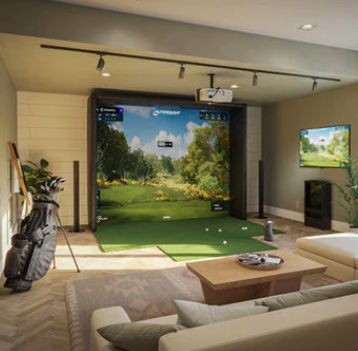Your golf simulator journey begins with this webinar
14 May 2023
by Todd Mrowice of AmateurGolf.com
see also: Equipment Reviews
SHARE:
We here at AmateurGolf.com consider ourselves a premier source for many aspects of the game we all know and love. Setting up golf simulators, however, is not one of them. Thankfully, I was invited to take part in a webinar co-hosted by our friends at ACE Indoor Golf and Yardstick Golf to learn more about what’s happening in the prevalent golf simulator market and get some tips and tricks from the experts on my setup. As one of over 100 guests that ranged from industry professionals to golf course managers and everyday consumers, here are some of the highlights from this great webinar.
Note: If you would like to watch the entire webinar for yourself (which we highly suggest) you can catch it right here:
Hosts
Our hosts for this webinar were Reid Colson, Founder of YardStickGolf.com, and Joe Neumeyer, Co-Owner of ACE Indoor Golf.
Hanging Your Screen
Neumeyer noted that there are (conservatively) around 10,000 simulator screens that have been installed by his company over 18 years, so to call him an expert would be more than accurate.
When possible, use the full width of the room.
-ACE Indoor Golf recommends using screens that have webbing on the sides to go along with #4 -grommets which allow for cable ties to be used on all corners.
-Whatever width you have for the screen, subtract 3 inches to allow for proper tightening.
-Your screen should always be flush with the floor.
Projector
-Your first step is figuring out your viewable image which will be a 4:3 aspect ratio or 16:9.
-Once you know your viewable image, determine where you want to place your projector. Floor-mounted setups are not preferable and you should always aim to have the projector behind the golfer.
-Look for projectors with a throw distance of 1.09 and above to best accommodate a simulator setup.
Tight Spaces
-If you can swing a club in the space, you can do something.
-Keep your screen 7-8 inches off of the wall to avoid damaging the area behind it.
-Tight spaces most likely require only a 4:3 aspect with short throw projector. No need to purchase anything more than that.
-Radar-based launch monitors typically will not work in smaller spaces.
Prioritizing Purchases on a Budget
We all have a budget to stay within, but if you’re trying to build out a sim on a tight budget, Neumeyer recommends going in this order:
-Buy your launch monitor first. There are plenty of options that exist for under $500 that perform well.
-Consider going with a simple net system to save your money. You can always expand down the road.
-Hook up a computer to a small TV so that you can see your shots.
 A golf simulator to fit your space exists, no matter what the dimensions may be
A golf simulator to fit your space exists, no matter what the dimensions may be
After taking part in this webinar I’m excited to kickstart my personal at-home simulator journey. As a midwesterner that is forced to put my sticks in hibernation come winter, I’m excited and encouraged by all of the possibilities. Neumeyer noted that the golf simulator market is currently around $1.3 billion and stands to be over $3 billion by 2030. Looking forward to becoming a slice of the pie.
If you’d like to learn more about ACE Indoor Golf or to watch plenty of helpful “how to” videos, visit them at
ACEIndoorGolf.com.
If you’d like to learn more about Yardstick Golf and how to begin your profitable golf simulator business you can visit them at
YardstickGolf.com.